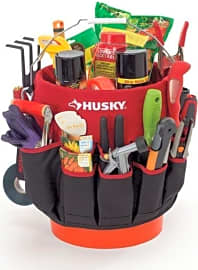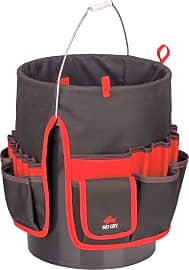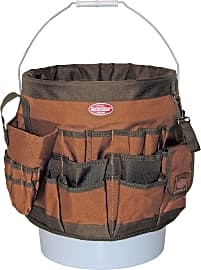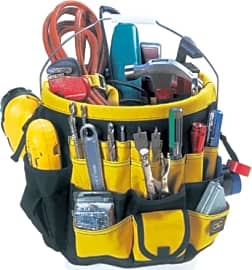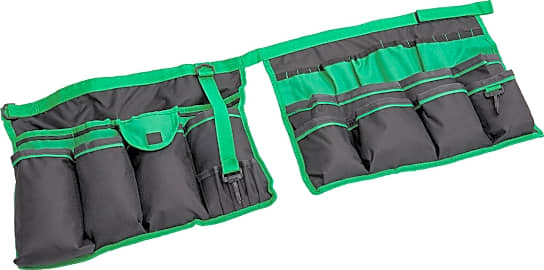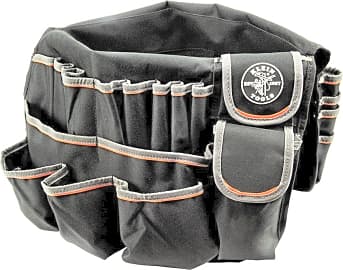The 10 Best Bucket Caddies

This wiki has been updated 35 times since it was first published in April of 2016. Tote around all the tools and accessories required for your next at-home project, professional job or fishing trip with one of these bucket caddies. Ideal for carpenters, plumbers, electricians, gardeners and anglers, these handy organizers slip over a range of buckets, and allow you to store all of your gear, and then carry it easily with one hand to wherever you need it. When users buy our independently chosen editorial picks, we may earn commissions to help fund the Wiki.
Editor's Notes
March 13, 2019:
Added the NoCry Standard to provide a simple, easy-to-use model that can be utilized for a variety of applications. The Readywares Waxed is a new addition as well, which exhibits high-end craftsmanship, properly sized pockets and a wealth of storage capacity. Removed the Attican Black Iron due to a lack of availability. Dropped the Klein Tools bag a bit in the rankings, as reports suggest that the outer pockets are too deep (swallowing screwdrivers and chisels), while some of the other pouches are too small. Also moved the Bucket Boss 10056 out of the top spot due to multiple complaints that many of the compartments are too shallow to securely hold certain tools, like screwdrivers and some wrenches. After noting a general consensus of satisfaction among users and considering its affordable price, we decided to move the Bucket Boss Bucketeer up in the rankings to reflect its exceptional value.
Your Caddy, Your Helper
Working with a bucket caddy is like having your own personal helper standing right next to you with just the tools you need.
Working with a bucket caddy is like having your own personal helper standing right next to you with just the tools you need. It has the advantage over a tool belt in that it doesn't hamper your range of motion, and it can hold larger items right along with your tools. Bucket caddies are also highly portable because they're a cinch to carry.
In fact, because of how handy they are, bucket caddies are the organizational item of choice for an incredible range of users. Contractors and builders are the obvious market, but those in plenty of other areas find them useful, as well. Fishermen, for example, might use these to keep their gear secure and at-hand in a boat. Crafters like them, too, since a good bucket caddy can hold all the tools that lead to a successful finished project, including a glue gun, scissors, adhesives, measuring tape, box cutter, and so much more.
There are even specialized versions designed specifically for certain groups of users. Those built for electricians, for instance, have slots for exactly those tools that an electrician needs most often, from wire strippers to a multimeter. Gardeners are another common user of the bucket caddy, so manufacturers produce those that tick all the gardening boxes, providing space for weeding knives, hand rakes, and everything else.
Of course, before you can get started with a bucket caddy, you'll need — wait for it — a bucket. Most bucket caddies are made to fit 5-gallon models, a common size used both around the home and on job sites. You'll probably need a round bucket, as well; most caddies are not shaped to fit square models.
Choosing A Bucket Caddy
When it comes to the wide world of bucket caddies, you've got plenty of choices; if you're looking for a starting point for your decision, you could do worse than to think about durability. Will the caddy be strong enough for what you're going to shove inside it? Was it made for light-duty use around the home or for rough and sturdy commercial construction work? The weight of the fabric can help you determine how rugged the caddy happens to be, but keep in mind that heavier fabric will mean that the caddy is heavier overall. If you don't need this bulky strength, then the lighter option could be the better choice.
Will the caddy be strong enough for what you're going to shove inside it?
You'll also want to consider the size and number of the integrated compartments and pockets. It's easy to assume that more pockets are always better, but be sure to think about the number and size of the items you need to transport. A caddy that offers 15 small slots might sound like a great deal, but if you need more room for extra-large wrenches or your power tools, then those small slots won't do you a lot of good. In other words, fitting the caddy to the tools, instead of the other way around, may just make your life easier.
Size and strength are easy to see, but washability is one feature that's sometimes overlooked. Your bucket caddy may often find itself in dirty, rough environments, so if it becomes caked with muck or starts to smell, you'll need to be able to clean it somehow. Some are spot-clean only, while others are tough enough to go through your washing machine. Remember that thicker fabrics can take longer to dry, too.
Finally, color and aesthetics will factor into your decision, although these may not be at the top of your features list. Nevertheless, you'll want to think about whether you need a style that will blend in, perhaps for fishing, or something high-vis, as in the case of construction site use. For around the house, you probably have more leeway and might choose based on how much you enjoy the look of the caddy.
Clean, Organized, Safe
Because bucket caddies typically have a lot of pockets and room, they can become cluttered more quickly than a less robust storage item. You might find yourself adding more and more items since the space is there, which makes it hard to grab what you want quickly. Or, you might end up with duplicate items, adding unnecessary weight. But there are a few strategies for avoiding these traps and getting the best organization possible.
You might find yourself adding more and more items since the space is there, which makes it hard to grab what you want quickly.
One thing you can do is take some time to consider how your tools work for you and place them accordingly. You'll be constrained to a certain degree by the architecture of the caddy, but within these constraints you can make wise organizational choices. At the most basic level, this means placing like tools next to each other so they're easier to find; with more in-depth reflection, you'll take into account the order in which you perform tasks, and group tools by use paired to similarities.
You'll also want to purge from time to time in order to get rid of those items that you don't use often enough to merit their own space. For the ultra-organized, this might mean a quick glance through the contents at the end of each day to ready the caddy for the next day. Those who take a more lax approach might try to do a clean-out once a month or so. Either way, removing those unnecessary items that find their way into your caddy will make it simpler to find what you're looking for and keep the weight down, too.
While you're cleaning out unnecessary tools, you could also take the time to maintain and clean both the items in the caddy and the caddy itself. This can be quite an important step since you can't visually inspect the tools in your caddy at a glance, as they are nestled within the slots. You'll have to take them out and give them a once-over; it might sound like a hassle, but using damaged tools can be hazardous, making a look every now and then worth the time and effort.



